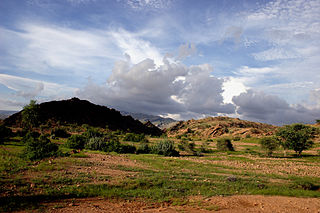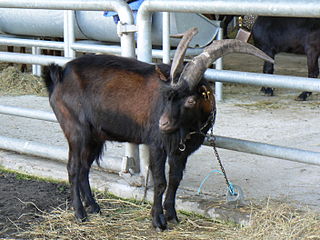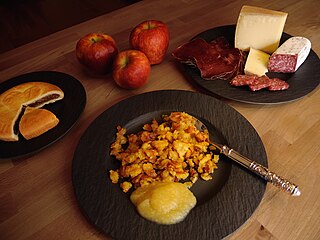
The Grisons Striped goat breed from Switzerland is very well adapted to mountainous landscapes. Breeders are in the process of selectively breeding it for improved milk production.

The Grisons Striped goat breed from Switzerland is very well adapted to mountainous landscapes. Breeders are in the process of selectively breeding it for improved milk production.

Romansh is a Romance language spoken predominantly in the Swiss canton of the Grisons (Graubünden). Romansh has been recognized as a national language of Switzerland since 1938, and as an official language in correspondence with Romansh-speaking citizens since 1996, along with German, French and Italian. It also has official status in the canton of the Grisons alongside German and Italian and is used as the medium of instruction in schools in Romansh-speaking areas. It is sometimes grouped by linguists with Ladin and Friulian as the Rhaeto-Romance languages, though this is disputed.

The Grisons or Graubünden, more formally the Canton of the Grisons or the Canton of Graubünden, is one of the twenty-six cantons of Switzerland. It has eleven regions, and its capital is Chur. The German name of the canton, Graubünden, translates as the "Grey Leagues", referring to the canton's origin in three local alliances, the Three Leagues. The other native names also refer to the Grey League. The Alpine ibex is the canton's heraldic symbol.

The striped hyena is a species of hyena native to North and East Africa, the Middle East, the Caucasus, Central Asia and the Indian subcontinent. It is listed by the IUCN as near-threatened, as the global population is estimated to be under 10,000 mature individuals which continues to experience deliberate and incidental persecution along with a decrease in its prey base such that it may come close to meeting a continuing decline of 10% over the next three generations. It is also the national animal of Lebanon.

A grison, also known as a South American wolverine, is any mustelid in the genus Galictis. Native to Central and South America, the genus contains two extant species: the greater grison, which is found widely in South America, through Central America to southern Mexico; and the lesser grison, which is restricted to the southern half of South America.

Cabecou is a soft goat cheese that comes from the Midi-Pyrénées region of southern France. It has a thin striped rind and after 2 weeks its crust grows blue mold changing its taste. It is one of Aquitaine's most famous foods. Aquitaine is a region in the lower bottom of France. The coloration of this creation is a calm cream color.

The greater grison, is a species of mustelid native to Southern Mexico, Central America, and South America.

The lesser grison is a species of mustelid from South America.

An over-frock coat is a formal overcoat designed to be worn over a frock coat if needed in cold weather. A top-frock coat may also be worn over a frock coat in milder weather. Shaped like the body coats popular in the late Victorian and Edwardian periods, the over-frock coat was cut in essentially the same way as the frock coat that was worn under it, although it would be larger overall to accommodate the frock-coat worn underneath. Like the frock coat, the over-frock would typically be single-breasted, with step lapels for informal occasions like business, and double-breasted with pointed lapels for formal occasions - weddings, funerals, balls, etc. The formal variety was sometimes called a Prince Albert overcoat. A frock-overcoat, like a frock coat, almost never has pockets.

Laives is a commune in the Saône-et-Loire department in the region of Bourgogne-Franche-Comté in eastern France.

The Romansh people are a Romance ethnic group, the speakers of the Romansh language, native to the Swiss canton of Grisons (Graubünden).

The Peacock goat breed from the cantons of Graubünden and Upper Tessin in Switzerland is used for the production of milk. There is little known about the origin of the peacock goat. The discovery of the peacock goat was in 1887. The name given to it after the discovery was the striped goat (Pfavenziege), but due to a reporter's spelling error, the goat was known as the peacock goat. The peacock goat also goes by the names of the gray-black goat, the gray-black-white mountain goat, and razza naz. The peacock goat is predominantly white with black boots, while the rear half is mostly black. The goat has a thick mid-length coat of hair. It has large horns, and dark facial spots/stripes from the base of the horn, over the eye, and to the nose which gave the breed their original name, the striped goat.

The Kirthar National Park, Sindhi is situated in the Kirthar Mountains in Jamshoro District in Sindh, Pakistan. The park was established in 1974, and encompasses an area of over 3,087 square kilometres (1,192 sq mi) - making it the third largest national park in Pakistan by size after the Central Karakoram National Park and Hingol National Park. The park is accessible by four wheel drive vehicles while two rest houses belonging to the Sindh Wildlife Department are available for tourist accommodation.
Striped goat usually refers to one of the following animals:

The Chamois Coloured Goat, French: Chèvre chamoisée, German: Gämsfarbige Gebirgsziege, Italian: Camosciata delle Alpi, is an indigenous breed of domestic goat from Switzerland. It is distributed throughout Switzerland and in parts of northern Italy and Austria, and has been exported to other countries including France. There are two strains, a horned type from the Grisons or Graubünden in the eastern part of the country, and a hornless type from the former bezirk of Oberhasli and the area of Brienz and Lake Brienz in the Bernese Oberland in central Switzerland. In some countries the hornless variety may be considered a separate breed, the Oberhasli goat. The Swiss herd-book was established in 1930.

The Frisa Valtellinese is an indigenous breed of domestic goat from the province of Sondrio, in Lombardy in northern Italy. It is raised throughout the Valtellina, from which its principal name derives, in the Val Malenco and the upper Val Masino in the Rhaetian Alps, and in the Valchiavenna. It may also be called the Frontalasca, for the village of Frontale, a frazione of the comune of Sondalo in the Val di Rezzalo, or the Rezzalasca for that valley. The name Frisa comes from its frisature, or Swiss markings.

The Capra Grigia, French: Chèvre grise des montagnes, German: Graue Bergziege, is a rare and endangered indigenous breed of domestic goat from Switzerland. It originates in the valleys of the cantons of the Grisons or Graubünden in the eastern part of the country, and of Ticino or Tessin in the south. It is possibly related to the grey type of the Passeirer Gebirgsziege from the Autonomous Province of Bolzano in north-eastern Italy.

The Alpina Comune is a heterogeneous population of domestic goats widely distributed in the Alps of northern Italy, particularly in the regions of Lombardy and Piemonte. It is highly variable in size, in morphological characteristics such as the type, colour and pattern of its coat and the shape and carriage of its ears, and in type of use. It does not display any of the uniformity characteristic of a breed, other than a consistent hardiness and adaptation to mountain terrain. It is however officially recognised and protected as one. The name Alpina Comune, "common", is more used in Piemonte; in Lombardy it may be called Alpina Locale, "local", or simply Nostrana, "ours".

Ictonychinae is a subfamily of the mammal family Mustelidae found mainly in the Neotropics and Africa, with one Eurasian member. It includes the grisons, Patagonian weasel, striped polecats, African striped weasel, and marbled polecat. These genera were formerly included within a paraphyletic definition of the mustelid subfamily Mustelinae.

Maluns are a traditional dish of the Grisons. They are essentially made of boiled and grated potatoes mixed with flour. The mixture is then slowly fried in butter until it breaks into little balls or crumbs. The dish is typically served with a compote of apple, or other fruits depending on the season, and various local cheeses and meat specialities, such as Salsiz or Grisons Meat. They are also traditionally eaten along with milk coffee.